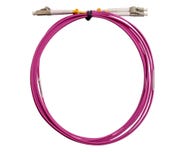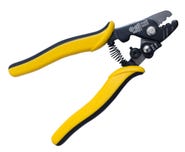

Should I use Singlemode or Multimode OM4 in a Fibre Network?
Single-mode fibre optic cable is typically used when longer distances or higher bandwidths are required in a network, while multimode fibre is suitable for shorter distances and lower bandwidths. This informative article will highlight some specific scenarios where single-mode fibre may be preferred over multimode.
At the beginning of the article, you’ll learn when to use a Single-mode rather than multimode fibre. In the second half of this article, we will explain what an OM4 Fibre cable is and will also mention its benefits.
Scenarios where single-mode fibre may be preferred over multimode
Long-distance transmission
Single-mode fibre can transmit signals over longer distances than multimode fibre. For example, single-mode fibre will likely be the better choice if you need to transmit data over several kilometres.
Higher bandwidth
Single-mode fibre has a much higher bandwidth than multimode fibre, allowing it to carry more data at high speeds. So, if your network requires very high bandwidth, always use single-mode fibre.
Security
Single-mode fibre has a smaller core and uses a single beam of light to transmit data, making it more difficult to tap or intercept. On the other hand, multimode fibre is easier to tap or intercept since it uses multiple beams of light.
Future scalability
If you expect your network to grow and require higher bandwidth or longer distances in the future, it may be wise to choose single-mode fibre so that you don’t have to upgrade your network later.
What is an OM4 fibre cable?
OM4 fibre, also known as Laser-Optimized Multimode Fiber, is an optical fibre cable specifically designed to support high-speed data transmission in optical networks. It is an enhanced version of multimode fibre (OM1 and OM3), so it offers improved performance compared to its predecessors.
Main benefits of OM4 fibre cables
High Bandwidth
OM4 fibre has a higher bandwidth than previous generations of multimode fibre, allowing it to support faster data transmission over longer distances.
It can support data rates of up to 100Gbps over a distance of 100 meters, making it ideal for high-bandwidth applications such as data centres, cloud computing, and video streaming.
Transmission Distances
OM4 fibre can transmit data over longer distances than previous generations of multimode fibre. So, it is a good choice for building and campus networks where longer distances are required.
Lower Power Consumption
It requires less power to operate than other types of fibre, reducing energy consumption and costs.
Future-Proofing
Installing OM4 fibre cable ensures your network can support future technological advancements and bandwidth requirements. It is compatible with OM3 fibre, allowing you to upgrade your network in stages as needed.
Cost-Effective
Usually, OM4 fibre is more expensive than older generations of multimode fibre, but it is generally more cost-effective than single-mode fibre, due to the cost of transmission equipment, and can offer better performance for certain applications.
Conclusion
As promised at the beginning of this article, we have revealed the scenarios where it is best to use Single-mode fibre rather than multimode. Moreover, we have also explained what OM4 fibre cable is and also mentioned its benefits.
Finally, we can say that OM4 fibre cable is a good choice for network applications that require high-speed data transmission over shorter distances. Its higher bandwidth, lower power consumption, and future-proofing capabilities make it a versatile and reliable option for several network environments.
It is also worth noting that installing single-mode fibre is generally more expensive than multimode fibre, and it requires more precise installation and alignment of the optical components, which can increase installation costs.
Recent Articles

Test Network Cabling & Patch Cords FAST with the New DATATESTER by CABAC
Testing LAN cables is quick and easy when you’ve got the new CABAC DATATESTER on hand. This budget LAN cable tester is perfect for contractors who need to test data and coaxial cable for correct termination.
View Products
Exploring the Advantages of Thin Patch Leads
For Australian data installers, selecting the right network components is critical to achieving the performance and reliability that your customers expect. Among these components, the humble patch lead plays a crucial role in interconnecting various devices.
View Products
FOBOT Buying Guide
In this informative article, we will provide a basic buying guide for FOBOTs or “Fibre Optic Break Out Trays” so that you can choose the right product for your specific needs.
View Products
What is a FOBOT?
In this article, we will explain what a FOBOT is and where they are used. We will also describe how a FOBOT works and the important role this component plays in managing and distributing optical fibres efficiently. So, if you're looking to learn all about FOBOTs, make sure to read this article...
View Products
What is the difference between OS1 and OS2 Singlemode Optical Fibre?
This technical article delves into the differences between OS1 and OS2 Singlemode fibre optics, including their core characteristics, performance specifications, and ideal applications.
View Products



















